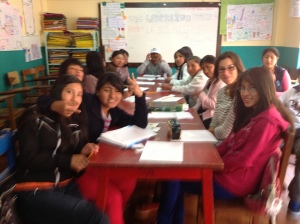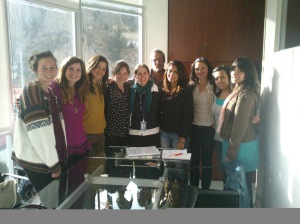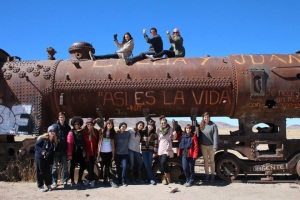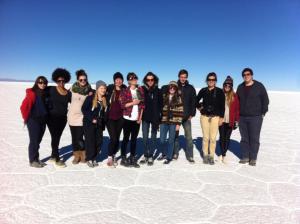Blog Archives
Dina’s ChildFund Project Reflections
As we approach the end of our three months volunteering here in Bolivia, it’s time to reflect on the impact our work has had on the communities with whom we’ve been working. Has our presence in La Paz made a difference in the lives of the locals here and contributed to the country’s development? As volunteers under the International Citizen Service scheme, we hope to develop ourselves as “global citizens” whilst making a positive contribution to various disadvantaged communities in developing nations around the world. The bigger aim is to work towards achieving the UN Millennium Development Goals by their 2015 deadline.
As 21 volunteers here in La Paz, our work is incredibly diverse. From teaching mothers about sexual health and offering discounted smear testing to building a greenhouse in the city of El Alto and educating the local communities about diet and nutrition; we are involved in many different areas. Our aim is to make our presence positively felt by a diversity of people in a variety of parts in need of being addressed. Prior to our arrival in La Paz, we had little idea about the specific details of our work making it all the more challenging once we got started. I think it’s safe to say that, as a group, we have put our all into our projects and have tried to take advantage of every opportunity to make a difference and a lasting, sustainable impact. Volunteers in El Alto, for instance, have sought to set up an on-going clothes recycling scheme to encourage volunteers and charity staff to donate any unwanted clothing to the communities here. Others, in various children centres and down in the district of Mallasa, have been working hard designing and painting murals and there’s even a garden being landscaped by a volunteer in one of our newest centres. It seems that, as we shortly prepare to leave La Paz, we will be able to say that we have made some difference here in Bolivia.
Personally, I have been working with adolescents and young people in a youth centre in Miraflores in association with the international charity ChildFund. My class is made up of a diversity of young people, mainly girls, between the ages of 12 and 17 who attend the centre when they’re not at school. I have been organising a range of interactive activities to teach the class about important themes and values, themes which are unlikely to be covered by their everyday curriculum at school but which are nonetheless vital to learn about.
I started out by running a class on self-esteem and confidence which was fortunately very well received by the students. It was my first chance to get an insight into the minds of the students and their thoughts on important issues such as prejudice and discrimination. Fortunately, contributions to the class discussion weren’t lacking and it was fantastic to receive feedback and opinions from so many of the students. I presented a video in which an office worker has a deformed face and is teased because of his appearance. After watching this, the class completed a worksheet which I had prepared and we went on to discuss their responses. The students were very receptive to the message of the video and even contributed their own personal stories on discrimination and bullying. I was very pleasantly surprised with their honesty and I think the activity helped to bring them a little closer as a class.

Dina Fahmy working with the students in her class
Next, I wanted to teach the class about the importance of a healthy diet and which foods offer the best nutrition. In order to make things a little more interactive and entertaining, we spent the first part preparing a fruit salad! This proved to be a great way to teach the students about the nutritional content of different fruits and vegetables. Ideally, the students will share what they’ve learnt with their friends and families and will use the nutrition worksheets I provided them with for future reference. It was a fantastic surprise when I returned to the centre the following week and found some of the girls snacking on apples instead of their usual lollipops and sweets before class.
We have also covered themes such as relationships, decision-making and leadership; with every class I have gotten closer with the students and learnt more about them and their interests. It is really promising to see that they’re an optimistic lot and have bold dreams and goals for the future. During my time working at the centres, I have tried to instil as much confidence in the students as possible, encouraging them to aim high. While the class is mixed, it is mainly girls and it is brilliant to see such strong, confident girls in action here in Bolivia, which statistically does not boast the best gender equality. Amongst the students are girls who want to become engineers, nurses, chefs, girls who want to go into higher education, girls who want to see the world – they are not discouraged from expressing their opinions and from dreaming big, and I really hope that they are able to make their dreams a reality.
In addition to my work in the centres, I have been working with the rest of the ChildFund volunteers in contributing to the development of a curriculum. Work on this curriculum began with previous cohorts of ICS volunteers and we arrived in La Paz in time to work on the final stages of its production. Education here in Bolivia lacks any established framework for teaching young people about sexual and reproductive health, or anything which could be seen as an equivalent to other national sexual education courses such as the compulsory Physical and Sexual Health Education syllabus we have in England. This could be down to a multitude of reasons in this developing nation, but taking an “out of sight, out of mind” approach is clearly proving ineffective as we see the teenage pregnancy rates are higher than in many of Bolivia’s neighbouring countries.

ChildFund team handing their Sexual Reproductive Health curriculum to Ana Vacas, ChildFund Youth Director
Thus, the curriculum is not intended as an academic curriculum but as a means of educating children, adolescents and youth about the body, relationships, sexual health and responsible decision-making. Initially, the curriculum is to be used in centres around La Paz and ultimately it is hoped that it will be branched out nationally. It is exciting to see how this curriculum will progress and how well it will be received here in Bolivia, where the topic of sex remains a sensitive one. However, it is still early days as we have just recently made the handover to Ana Vacas, the ChildFund youth director. Judging from her reaction though, things seem highly promising!
It hasn’t all been plain sailing here in La Paz; we’ve faced our fair share of obstacles. From irregular schedules and cancelled classes to Salmonella and E-coli; we’ve experienced it all. But we’ve pulled through and managed to keep our spirits high without losing sight of why we’re here. As we get ready to descend from the highest capital in the world, I can safely say that it has been an experience of a lifetime. Alongside working on our projects, we have been exposed to some of the world’s most beautiful landscapes and have shared some incredible experiences from touring Salar de Uyuni and the gorgeous lagunas, to joining the locals in the fiestas of Copacabana and La Paz’s Gran Poder. This experience has taught me a great deal about international development and has contributed to making me a more global citizen. Leaving Bolivia, I hope that our presence has had a positive influence on the communities here and that the ICS scheme continues to assist in development, working with Bolivians in making the most of the rich potential this unique country has to offer.

The volunteers exploring the unique train cemetery on the Salar de Uyuni tour
Written by: Dina Fahmy
Edited by: Liam Hilton




